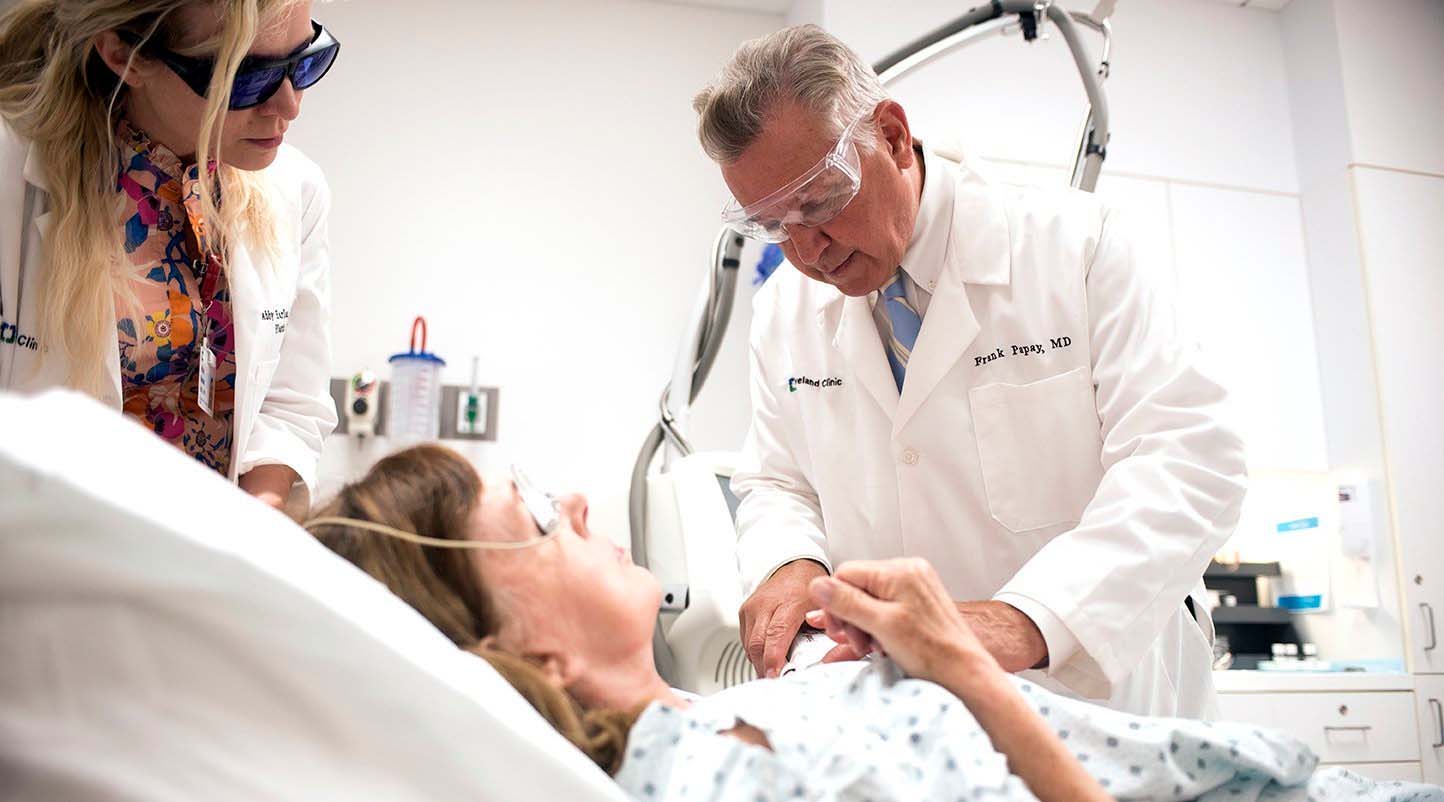
Frank Papay would arrive in early morning at Professor Rush Elliott’s house on Athens’ east side. It was 1974 and Papay was summering in the city to paint houses and earn money to pay for fall tuition. What he remembers most isn’t the paint color used on the house Elliott, AB ’24, EMERT ’73, shared with his wife, Frances. Instead, Papay remembers the connection he made with the revered scholar during long morning walks.“
And that’s when I really, really got to know him,” says the now world-renowned surgeon. “I developed a real deep relationship with him and his wife. And now, as I go through life, I think, ‘Jeez, if I can only be half that impactful through people’s lives.’ That’s pretty amazing.”
Elliott’s gifts as teacher and mentor introduced Papay, during those formative years, to the foundation of servant leadership, a model in which a leader puts “the growth and well-being of people and the communities to which they belong” ahead of self, wrote Robert K. Greenleaf in 1970.
Today, the servant leadership model is baked into Papay’s practice as a surgeon and team leader at Cleveland Clinic. It’s central to how he relates to patients and their families and with his colleagues—doctors who are rising in their careers as surgeons, future leaders, and, perhaps one day, mentors themselves.

Rush Elliott, AB '24, EMERT '73, served as dean of the College of Arts and Sciences from 1956-1966. Photo courtesy of Mahn Center for Archives and Special Collections

Dr. Frank Papay embraced servant leadership early in his career thanks to his relationship with his mentor, the late Professor Rush Elliott. Photo by Tim Harrison
Making a Commitment to His Patients
Papay, AB ’75, is a craniofacial surgeon and chair of Cleveland Clinic’s Dermatology and Plastic Surgery Institute. His career arc includes expertise in cranial facial surgery, serving babies born with cleft lip, cleft palate, and other facial deformities. His tasks at the clinic are to “advance the evolution of surgery through technical innovations, create new surgical techniques, and grow across medical specialties.”
Papay was heralded in 2008 for leading a surgical team that performed America’s first face transplant, and again in 2018 for leading a team of 11 doctors who performed Cleveland Clinic’s first-ever full-face transplant on Katie Stubblefield. At 21, Stubblefield became the youngest person in the United States to receive a complete face transplant. The case, documented through a story in National Geographic, gave Papay world-wide recognition. Yet, as a student of servant leadership, what’s central for him isn’t fame. It’s serving patients through building solid relationships with them and their families, in some cases for years after surgery.
“Because that’s the expectation you place on yourself in order to really see that person from childhood through well into adulthood,” he says. “The relationship isn’t just one surgery, especially in cleft lip and palate. It’s performing multiple, multiple surgeries throughout that lifetime or at least the early-year lifetime of those individuals. So, I’m developing a relationship with the child, with the parents. I’m also making a commitment to them that I will follow through with this till they’re done, or I’m done, or both.”
Papay asks his staff to share their personal sense of each patient before they arrive for the first appointment—launching the relations before the first meeting. Why all the pre-work? Because strong internal communication is key to making sure patients have a positive first impression, he says.
“They sort of tee it up. … You can end up getting it from the front desk, then you get opinions from the people in that room, then the nurses ... and, then, me last,” he says. “You’ve got to make sure everybody’s on the same page … everything is perception.”
Communication is Key
A patient’s first impression of the doctor—and vice versa—impacts not only the strength of their relationship but health outcomes as well, says Parul Jain, associate professor of journalism at OHIO’s E.W. Scripps School of Journalism and an expert in doctor-patient communication.
“Research about first impressions can involve many things, including how a doctor dresses (white coats influence credibility), their bedside manners, and communication skills,” Jain says. “First impressions can be significant in setting the tone for the long-term care relationship.”
Once a solid foundation in communication and that first impression is established, the task of building trust commences. For Papay, trust plus communication equals a solid relationship, he says. The research backs this up, says Jain.
“[The] research is unequivocal in suggesting that [a] good patient-provider relationship leads to enhanced trust, satisfaction, compliance, adherence, and overall better health outcomes for the patient,” she says.
When the dynamic between Papay and his patients shifts—when they go from sitting across from him in an examination room to lying supine on a gurney headed toward a surgical theater—having a strong relationship is crucial, he says.
“Trustworthiness, to me, is a sense of predictability in somebody’s actions and personality and statements,” he says. Papay says he always talks to his patients prior to surgery, offering a supportive touch of the patient’s hand or forehead. “I say, ‘Listen, I’m here, you’re fine. I’ll take great care of you.’”
For Katie Stubblefield, the complete face transplant recipient, and her family, especially her parents, Robb and Alesia, their relationship with Papay was paramount to her successful health outcomes. Papay remains in awe of all of them, especially of Robb and Alesia.
“What impacted me was really the support that the mother and father gave and how family is so important. How that family came together despite this horrendous thing that happened to not just Katie, but to the family. That, I just ... I’m amazed of how that happened.”
Like Elliott, Papay champions the surgeons, leaders, and future mentors who will follow him.
“My job is to make them better than me,” he says. “I think…impactfulness is a key component.
“I want to help them, guide them about what I’ve learned, right or wrong, through this.”
How employees relate to work culture has evolved, and leaders must keep up, Papay says. Boomers were expected to “work hard and achieve what you can achieve,” he says. Today’s workers seek more of a work-life balance. “And so, we have to respect that.”
As more women enter medicine, leaders must embrace that evolution, too.
“How do we, through a group of collective action surgeons, work together? If somebody has a baby, they can take time off, or somebody has young school-aged children, they come in a little bit later,” he explains. “We have to understand that and bring in the relative aspects of diversity.”
“As a servant leader, I have to understand even though I’m not a woman or of color, I have to, to the best of my abilities, ask from their perspective what’s the best way to achieve where they can go in their lifetime, better than where I’m at right now?”

Doctor Frank Papay consults with Melanie before performing a procedure at the Cleveland Clinic, July 24, 2019, in Avon, Ohio. Photo by Tim Harrison
Papay meets with Melanie* during Ohio Today’s interview. Melanie had a double mastectomy after being diagnosed with carcinoma in situ in her breast, a cancer designation indicating abnormal cells have remained where they first formed. Because Melanie has a family history of breast cancer, she underwent a double mastectomy. “It wasn’t a big decision for me to do that,” she says.
Melanie and Papay are addressing her keloids, ropy scar tissue that can develop after surgery. Four of Papay’s staff are in the room, ready to give Melanie care. A Fraxel machine, the device that reduces the keloids, is rolled in.
Before he begins his consult with Melanie, Papay invites her to tell Ohio Today her story. She does so, with confidence and detail. He’s grinning.
“So, as you can see, she’s well educated,” he says proudly.
Then he turns his focus to her and does what he’s there to do. Serve.
*Only Melanie’s first name is used to protect her identity.
Feature photograph: Dr. Frank Papay with Melanie and Abby Harlan, CNP [LEFT], at the Cleveland Clinic’s Richard E. Jacobs Health Center in Avon, Ohio. Photo by Tim Harrison





